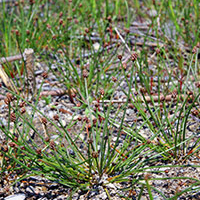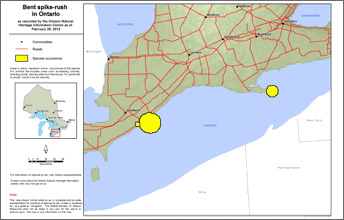Bent spike-rush
Scientific name: Eleocharis geniculata

Cover photo credit: Sam Brinker
Status
Endangered
Endangered
means the species lives in the wild in Ontario but is facing imminent extinction or extirpation.
Date added to the Species at Risk in Ontario List
September 10, 2009.
What it looks like
Bent Spike-rush is a small, green to greenish-yellow, tufted annual sedge with multiple slender, erect stalks. Stalks grow up to 40 cm long, each ending in a single spikelet.
The spikelets are composed of at least 10 tiny flowers that produce tiny black seeds. No other tufted Canadian sedges have black seeds.
Where it lives
In Ontario, this species is found on wet, sandy to muddy soil in open flats along the shore of Lake Erie.
It occurs occasionally along the edges of wet meadows and seasonal ponds further inland.
Where it’s been found in Ontario
Bent Spike-rush is primarily a tropical species. In North America, it occurs in the Gulf of Mexico region, with geographically separate populations in British Columbia and the Great Lakes basin.
In Ontario, it occurs along the shore of Lake Erie, and at one inland site.
View a Larger version of this map (PDF)
What threatens it
The greatest risk to Bent Spike-rush in Ontario is habitat degradation caused by the spread of an invasive species called the Common Reed (a Phragmites species).
The Common Reed can spread quickly and forms dense stands, effectively crowding out native wetland plants.
Action we are taking
Endangered Species and their general habitat are automatically protected
Recovery strategy
A recovery strategy advises the ministry on ways to ensure healthy numbers of the species return to Ontario.
Read the executive summary (September 10, 2010)
Read the recovery strategy (September 10, 2010)
Government response statement
A government response statement outlines the actions the government intends to take or support to help recover the species.
Read the government response statement (June 15, 2011)
Five-Year Review of Progress
A five-year review reports on progress made toward protecting and recovering a species, within five years of publishing a species’ government response statement.
Read the report on progress towards the protection and recovery of 27 species at risk, including Bent Spike-rush (2016)
Habitat protection
A habitat regulation defines a species' habitat and many describe features (for example, a creek, cliff, or beach), geographic boundaries or other unique characteristics.
Read the habitat summary (July 1, 2012)
Read the regulation (July 1, 2012)
What you can do
Report a sighting
- Report a sighting of an endangered animal or plant to the Natural Heritage Information Centre. Photographs with specific locations or mapping coordinates are always helpful.
Volunteer
- Volunteer with your local nature club or provincial park to participate in surveys or stewardship work focused on species at risk.
Be a good steward
- Private land owners have a very important role to play in species recovery. If you find Bent spike-rush on your land, you may be eligible for stewardship programs that support the protection and recovery of species at risk and their habitats.
- Harmful alien organisms whose introduction or spread threatens the environment, the economy or society are called
invasive species.
These invaders seriously threaten many of Ontario’s species at risk. To learn what you can do to help reduce the threat of invasive species, visit: Invasive species in Ontario - Ontario's Invading Species Awareness Program
- The Carolinian forests of southern Ontario support an amazing diversity of plants and wildlife, including many species at risk. Carolinian Canada is working to help recover species at risk and their habitats.
Report illegal activity
- Report any illegal activity related to plants and wildlife to
1-877-TIP-SMNR (847-7667) .
Quick facts
- The two Ontario locations where Bent Spike-rush grow support fewer than 2,500 plants.
- The Bent Spike-rush can store seeds in the soil for years waiting for the right conditions to grow. This strategy, called banking, allows the species to make the most out of future good growing seasons.
- Ontario is home to less than one per cent of Bent Spike-rush’s global range.
